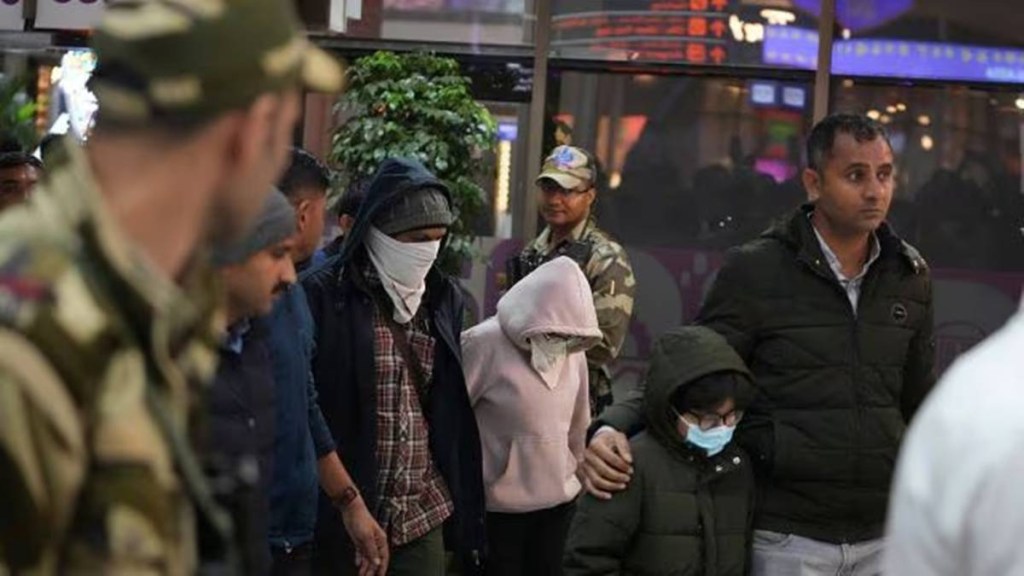A group of more than 30 Indian nationals, along with 300 other deportees from countries such as Iran, Nepal, Pakistan, China, and Afghanistan, has arrived in Panama after being deported from the United States. These individuals, part of a larger group sent back as part of US immigration policies, are currently being held in Decapolis Hotel Panama, Panama City.
The Indian Embassy in Panama confirmed that the deportees are “safe and secure at a hotel with all essential facilities.” In a post shared on X (formerly Twitter), the embassy further noted that consular access has been provided, and they are in close contact with local authorities to ensure the well-being of the individuals.
https://x.com/IndiainPanama/status/1892436359551259096
“We are working closely with the host government to ensure their well-being,” the Indian embassy stated. While they are being provided with food and medical assistance, concerns about the detainees’ future remain.
Videos from the hotel show migrants displaying signs such as ‘Help’ and ‘We are not safe in our country,’ indicating their uncertain situation.
The Impact of Human Trafficking Following the Pandemic
FinancialExpress.com has previously reported the deportees’ journey to the US was not without its challenges. Many migrants, including the Indians, had been deceived by human traffickers, spending substantial amounts of money to travel through dangerous Latin American routes with the hope of reaching the United States. The global lockdowns during the COVID-19 pandemic led to a sharp increase in human trafficking, as closed borders forced many individuals to seek illegal means to migrate.
“Many of these people were victims of traffickers who exploited their desperation during the pandemic,” said a migration expert. “The economic impact of COVID-19 left many people vulnerable to these schemes, which often promised safe passage to the US.”
Migrants from different states of India — from Punjab, Gujarat, Uttar Pradesh, Haryana, Maharashtra, Andhra Pradesh are willing to pay several thousands of dollars to reach their dream country – either the US or Canada.
FinancialExpress.com has previously reported that once these young men and women reach one of the countries in South America which issue visa on arrival they then start moving in groups and work in local shops or restaurants. And at times are used as narco-mules.
The migrants whose final destination is the US prefer going through countries including – Brazil, Bolivia, Chile, El Salvador, Costa Rica, Peru, Ecuador, Paraguay, Ecuador, Guatemala, Panama, Colombia and Nicaragua.
FinancialExpress.com has spoken with top diplomats of some of the countries in the region who have admitted that trafficking from India and other countries in Asia (Nepal, Pakistan, Sri Lanka, Bangladesh, China, and Afghanistan) has become a huge problem. Speaking on condition of anonymity, one top diplomat indicated “All stakeholders including the missions and governments are working together in an effort to stop the trafficking and to ensure strict action is taken against them.”
In Panama, these deportees face an uncertain future. While the Panamanian government has provided them with food and medical care, the lack of clarity regarding their repatriation or relocation has raised concerns among human rights groups. Local activists have warned that the ongoing detention, though not officially classified as imprisonment, continues to take a toll on the migrants’ mental well-being.
Panama Role as a Transit Hub
As part of a migration agreement between the US and Panama, the Central American nation is temporarily housing deported migrants, including those from India, while the US government covers the costs. Panama is now working on finding solutions for these individuals, including potential relocation to third countries or repatriation to their home nations.
As the situation evolves, the deportees remain in limbo, awaiting final decisions on their repatriation or relocation.
How challenging is the journey through the Darien Gap?
The Darien Gap is a treacherous, lawless region located on the border between Colombia and Panama, home to dangers ranging from venomous snakes to anti-government guerrillas. The dense jungle can only be navigated on foot or by canoe. This wilderness also serves as a natural divide between North and South America, crossing through Central America. The area sees a constant flow of migrants from Cuba, Africa, and Asia, who, driven by desperation, undertake a perilous journey toward the US and Canada, facing risks such as robbery, kidnapping, and even death on one of the world’s most dangerous routes.
How Migrants Travel Through the Gap
The journey through the Darin Gap typically takes 6 to 8 days on foot, or up to 10 days during the rainy season. The region is marked by constant rain and high temperatures averaging 85°F. In 2019, the United Nations reported that 17,668 migrants passed through this part of Colombia, including 3,170 Haitians. On average, migrants pay more than $5000 to pass through Colombia. In 2019, several Indian nationals were deported from Colombia for attempting to enter Ecuador illegally.
